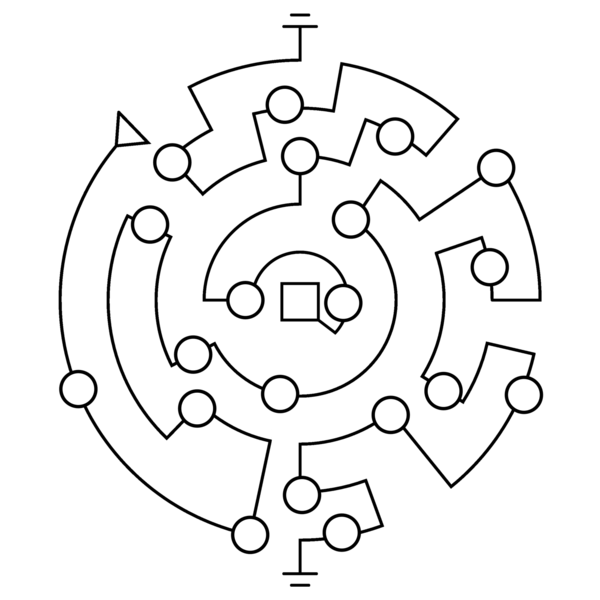Eye Sigil ARG/Map Speculative Theories
Main Page > List of Investigations > Eye Sigil ARG > Map Speculative Theories
WARNING: This page is a list of speculative theories! Even though some of them might hold some ground, nothing here should be taken for granted and exists as a starting point for further investigations. It also has a temporal nature — it will serve no purpose and will probably be deleted once the Map is finally figured out.
- click through for a bigger version
All of the games contribute to uncovering this image. We call it a map not just because it looks like one, but also cause at least some of the games refer to their pieces images as map piece themselves.
General understanding
The simplest and thus generally accepted theory is that the map is a path that starts at the triangle, goes along the lines through all the circles, warps across through the ground symobls (think pacman levels) and ends on the square symbol.
Sometimes, for simplicity of understanding, the map is cut into two pieces and joined at the ground symbols like this. It's open for consideration if this is required.
Pros: The triangle looks like "Play" button and square as "Stop" button commonly used in music and video players.
Redundancy
A lot of the game's pieces cover the same spots of the map. At least 6 pieces can be removed without damaging the full picture. The easiest way to explain it is redundancy: this way, if the community solving the ARG doesn't find all the needed pieces, they still can get the overall map.
Fuzziness
The pieces that form the map come into play at different scales or even artistic styles, and sometimes have to be extracted from screenshots at angles, so they don't fit with one another precisely. The exact locations of all the circles, exact positions of all the lines and corners should be not be considered as part of the puzzle. It's all just fuzzy approximations.
One circle per arc
It looks like the circles are either on the corners of the path or on the arc (usually closet to the center, though there are exceptions). There is no two circles on the same arc, if one doesn't take corners into account.
Map as a clue
The map might not be a self-sufficient puzzle, but be a clue to something else.
Pros: map itself doesn't include an obvious way to read it, being a supplement is easier and/or more apparent
Cons: clues for the ARG only come in ways of sigils and puzzle pieces — something outside of those raises questions of authencity (hoaxes are fairly easy to make);
Overlay
We are supposed to overlay the map image on something and read the result in the circles along the path.
Should probably be some circular grid of letters, though regular "square" grid is a possibility too.
Real world maps
People have tried and suggested overlaying the map over real-life maps, though that requires knowing exact spot and scale.
The overall earth globe is too vague due to fuzziness of all circles.
Canberra come up most often, being used as the name of the secret level in Mini Metro.
Maze path
The map might be an instructions to navigate a maze. One would assume that the maze would not have an obvious path, so something like this
Map as self-sufficient puzzle
The map might be solvable on its own, as a self-sufficient puzzle.
Pros: clues for the ARG only come in ways of sigils and puzzle pieces; having it solvable from them would make elegant design for the ARG
Cons: not apparent, how to read it.
Correlation between circles and pieces
The number of circles and pieces might be the same. Figuring out how they correlate gives us a chance to assign each circle node something from the game "its piece" came from and read the result along the path.
Cons: the redundancy becomes questionable as (almost) all pieces are needed to read the answer
Fully enclosed circles
There is a theory that you should assign circle nodes that are fully enclosed in the pieces to those pieces. When there are multiple — exclude the ones "taken" by other pieces already. Read more here.
After its postulating, this theory "predicted" the Clockwork Empires piece that would cover 100% discovered path again. However, Bombernauts piece almost sinked it and it had to be adjusted to include triangle shape as "assignable" too. The theory might be completely sunken by more pieces yet.
Assigning numbers
There are multiple ways to assign numbers to the circle nodes.
Distance from the center
Number of pieces covering it
See here
Just like another theory above, this ones requires finding all the pieces that makes the employed redundancy questionable.
Notes staff
Since there are 5 concentric circles and the nodes are either on them or between them, the map can be interpretted as a musical notes staff
Pros: location of the circle nodes
Cons: unknown lengths of the notes
TODO: write down actual notes
Reading along the path
It's possible to get some string of data by going along the path and algorithmically extract data from what is occuring.
If you're trying to get binary data, try to assemble them in groups of 8 into bytes.
It's also possible to extract three types of things and turn them into morse (dots, lines and separators).
Circle nodes and corners
Take any circle nodes as 0 and circleless corners as 1. There will be 56 bits from this. full theory here. Arranging them into bytes gives -ª▌╓╜▐┌ in DOS/IBM ASCII
Taking circle nodes as 1 and circless corners as 0 gives ╥Y"*B!& in DOS/IBM ASCII (only the first character is from the extended part of ASCII).
